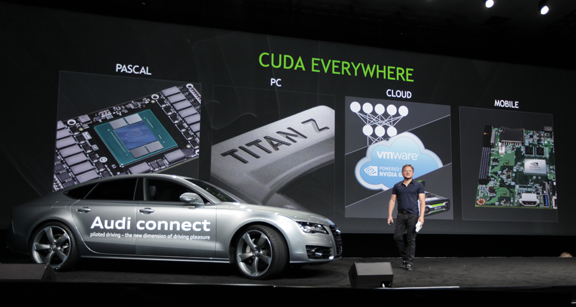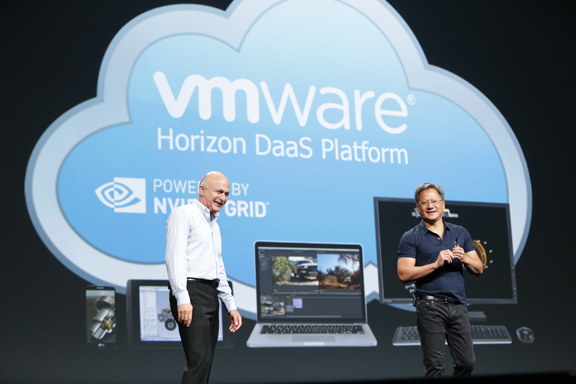March 27, 2014
This week, at NVIDIA GPU Technology Conference (GTC, March 24-27, San Jose, California), NVIDIA CEO Jen-Hsun Huang was almost upstaged by an Audi. The self-driving Audi Connect drove itself onto the stage, providing the big finish for Haung’s keynote on Monday.
Before he shared the stage with a driver-less car, Huang also shared the stage with Ben Fathi, CTO of VMware, the company that might foster enterprises operating in a computer-less environment. Haung introduced Fathi as the point man from “the largest and one of the most important virtualization companies in the world.”
Fathi and Huang took the opportunity to discuss Horizon DaaS, VMware’s business that delivers Windows desktops as virtual machines available on-demand, accessible remotely. Just as SaaS vendors deliver software as a service over the internet, VMware plans to deliver “Windows desktops and applications as a cloud service, to any device, anywhere, with predictable costs,” explained the company.
The foundation technology is NVIDIA Grid’s GPU-based HPC hardware, and VMware’s cloud setup. VMware’s partner NaviSite is the first to offer Horizon DaaS products to enterprises. Later, in 2015, virtual GPUs will become part of Horizon DaaS offerings.
“The prototype is running in our lab,” said Fathi. “It’s looking great.”
Pat Lee, VMware’s director of end user clients, clarified that VMware itself also offers DaaS directly to end users; however, enterprises that want to implement DaaS solutions for its users will most likely be served by partners like NaviSite.
Huang described virtualizing the GPU—made possible by NVIDIA Kepler architecture—as “one of the greatest endeavors of [NVIDIA].”
Virtual machines have long been part of enterprise IT setups; however, they’re not usually considered ideal for applications that require interactive, real-time 3D graphics. At the present, those who work with compute-intense CAD and simulation software tend to rely on powerful workstations, as most would find virtual machines inadequate. But DaaS solutions with virtual GPUs offer tantalizing possibilities.
VMware’s Lee pointed out, with DaaS, “You don’t have to worry about maintaining the infrastructure; you can work from wherever you want; you just have a monthly charge.” The proposition is particularly appealing to businesses that want to be able to adjust the volume of desktops they deploy depending on seasonal needs and peak demands. Without upfront investment in hardware, they may rely on DaaS providers to deliver the additional computing power on-demand.
Virtual machines, unlike physical machines, are deleted once the users have cancelled their subscription. This feature may be viewed by some as a way to minimize IP compromise.
Design software with straightforward licensing policies (usually tied to a machine or a user) is easily deployed on DaaS products; however, for those using simulation software with licensing policies that restrict the number of cores that can be used, DaaS offerings may raise new questions on performance and licensing costs.
The Achilles’s heel to DaaS may be bandwidth. Lee assured that software like Dassault Systemes’ CATIA will perform on virtual machines with virtual GPUs just as it does on real workstations. However, the data transfer between the virtual machine and the client device—the tablet, laptop, or lightweight computer you’re using to control the virtual machine—affects the software’s responsiveness.
DaaS is the natural successor to—and perhaps the inevitable outcome out—SaaS, driven by the tech consumers’ desire to pay for access, capacity, and usage, not for ownership. The GPU, specifically the virtual GPU, plays an important role in promoting DaaS as a viable alternative to powerful workstations, as many design and engineering software relies on the graphics processor to produce physically accurate, ray-traced visuals that can pass for realism.
More reporting on NVIDIA GTC 2014 is set for next week.
Subscribe to our FREE magazine, FREE email newsletters or both!
About the Author
Kenneth Wong is Digital Engineering’s resident blogger and senior editor. Email him at [email protected] or share your thoughts on this article at digitaleng.news/facebook.
Follow DE







